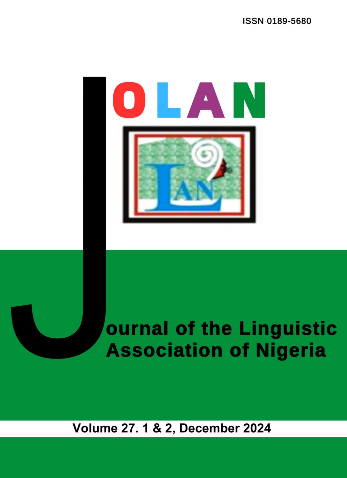Interference of ‘Diachronisms’ In Nigerian English (NigE)
Keywords:
Interference, diachronisms, ENE, diachronic linguistics, Nigerian EnglishAbstract
This paper examines the use of ‘diachronisms’ in Educated Nigerian English (ENE). Diachronisms is used here to denote old-fashioned words and expressions which come from old and past generation varieties of English and assume currency and ubiquity in (E)NE. The paper sets out to show the psycho-sociolinguistic causes of diachronisms in ENE, how they distinguish Nigerian English morphology and how they should be treated in the use, teaching, and description of Nigerian English variety. The paper is based on the concepts of ‘diachronic linguistic,’ and ‘interference.’ Observation and the recording of spontaneous speeches were used to gather examples which were further subjected to a nation-wide survey in a questionnaire to establish their currency and ubiquity in ENE, also Standard Nigerian English (SNE). The data were presented and analyzed in simple percentile and frequency tables and charts Results showed that diachronisms flourish in (E) NE, unlike in Standard British English (SBE) or Standard American English (SAE). The paper concludes that the use of diachronisms in Nigerian English (NigE) differentiates it from native English varieties. Since the diachronisms examined are institutionalised and widely accepted, and as they are not grammatical errors or embarrassing errors of interference, the paper argues that teachers of ESL and grammarians do not need to bother about them as they may worry about other egregious language infelicities.
References
Alexandra, H.A. (1969). The story of our language. New York: Nelson Publishers.
Banjo, A. (1970). The English language and the Nigerian environment. Journal of Nigeria English Studies Association. 4(1), 51-60.
Banjo, A. (1996). Making a virtue of necessity: An overview of the English language in Nigeria. Ibadan: Ibadan University Press.
Baugh, A.C. & Cable, T. (1988). A history of the English language. London: Routledge & Kegan Paul.
Beaugrand, R. (1991). Linguistic theory: The discourse of fundamental works. London: Longman.
Chomsky, N. (1965). Aspects of the theory of syntax. Cambridge: MIT P.
Croft, W. (2000). Explaining language change: An evolutionary approach. Harlow, Essex: Longman.
Croft, W. (2006). The relevance of evolutionary model in historical linguistics. In Ole Nergaard
Thomsen. (Ed.). Competing models of linguistic change: Evolution and beyond (pp.1-40). London: John Benjamin Publishers.
Crystal, D. (2009). A dictionary of linguistics and phonetics. 6th ed. Oxford: Blackwell.
Ekundayo, B. S. (2006). The concept of ‘interference’ in English: The morphemic examples in Nigerian English as second language. (Master’s thesis). University of Benin, Benin City.
Ekundayo, O.S.B. (2014a). Suggested spelling reform in Educated Nigerian English: Who bells the cat? SAGE Journals, 1-14.
Ekundayo, B.S. (2014b). Interference in Educated Nigerian English (ENE). (Doctoral dissertation). University of Benin, Benin City.
Hale, B. (2000). Interference mirror. Retrieved from www.barryhale.interferencemirrors May 2012.
Jowitt, D. (2008, 28 March). Varieties of English: The world and Nigeria. An inaugural lecture. University of Jos, Jos.
Kpolugbo, S.N. (2006). A concise history of the English language. Benin, Evans Publishers.
Labov, W. (1994). Principle of linguistic change. Vol.I, internal factors. Oxford: Blackwell.
Ogbulogo, C. (2005). Another look at Nigerian English. Covenant University public lecture series l1.5. Otta: Covenant University Press.
Richards, J. C. (Ed.). (1984). Perspective on second language acquisition. London: Longman.
Richards, J. C., & Sampson, G.P. (1984). The study of learner English. In Richards J.C. (Ed). pp. 13-18.
Saussure, F. (1966). Course in general linguistics. Wade Baskin. (Trans.). New York: McGraw Hill.
Selinker, L. (1984). Interlanguage. In Richards J. C. (Ed.), pp. 1-54.
Surakat, T.Y. (2010). Categorising varieties of Nigerian English: A socio-psycholinguistic perspective. Journal of Nigerian English Studies Association 13(2), 97-110.














